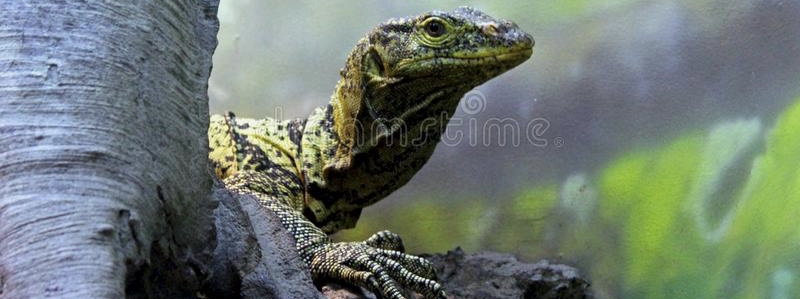ANIMAL: Gray’s Monitor Varanus olivaceus Type of Animal: Monitor Habitat: Tropical forest Location(s): Philippines in S Luzon, Catanduanes, & Polillo Island Appearance: Olive-green coloration w/ green ruffles on neck & long green tail, yellowish-green on belly Food/Diet: Fruit, snails, crabs, insects, spiders, eggs, birds, rodents Status in Wild: Threatened Conservation: Breeding in zoos & wildlife centers. Polillo Butaan Project investigated population trends on Polillo Island from 1999-2010. Lifestyle: Solitary Additional Info: Called: Male Female Young: Hatchling Group: Solitary Weight: Male: 14-15 lbs Female: 6-7 lbs Young: 5.29 oz Gestation: 10 months Life Span: 20-30 years Body Length: Male: 5 ft Female: 4 ft Young: 2 ft Tail Length: Male: 2.5-3.45 ft Female: 1.97-2.71 ft Only predators of adults are Philippine Eagles. Water monitors prey on young. Threatened due to deforestation, habitat loss, hunting for meat/skin, pet trade, agriculture, & restricted range. These lizards are arboreal but are also great swimmers. Also known as Butaan (local name) & Ornate Monitor (not to be confused w/ African species). Usually lay eggs from July-October, w/ clutches numbering 1-11 eggs. Eggs most often laid in tree hollows. These lizards are very uncommon in captivity Tail can be used to steer while swimming. Teeth blunt which come in handy for crushing shelled prey & eating fruit. Long tail comes in handy for holding onto things. Due to secretive nature, there’s a lot more to be learned about these lizards. Fun Fact(s): Will strike w/ long tail to defend itself. They can also bite. While there are other monitor lizards that periodically eat fruit, this & 2 other species in subgenus Philippinosaurus-Northern Sierra Madre Forest Monitor & Panay Monitor only ones where fruit very important component of diet (former being part of same species until 2010). All 3 of these species come from Philippines but don’t typically encounter one another. Frugivorous diet may be due to lessening competition w/ carnivorous water monitors. Dallas Zoo was 1st zoo outside of Philippines to breed this species, occurring in 1994. Unfortunately, hatchling soon died. LA Zoo 1st zoo outside of Philippines to have 3 successful young in 2015. Due to elusive nature, these lizards were thought to be extinct in wild until rediscovered in 1980s. Even in captivity, these lizards can be very shy.

